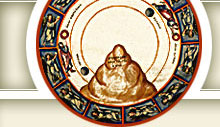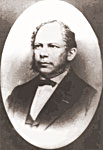Constantin von Tischendorff and his Collection
Constantin von Tischendorff (Lobegott Friedrich Constantin von Tischendorff) (18 January 1815, Lengenfeld - 7 December 1874, Leipzig), the discoverer of the Codex Sinaiticus, was a noted German theologian, from 1844 Professor at Leipzig University, from 1859 heading the chair of Biblical paleography.
Constantin Tischendorff, Constantin Tischendorff graduated from the University of Leipzig where he studied theology in 1834-1838. The young scholar began working upon a critical study of the New Testament text with encouragement from his teacher, Professor Johann Georg Benedict Wiener. He set himself the ambitious task of publishing all available Greek versions of the New Testament written in uncial script, as well as, revising previous publications. To achieve this goal, Tischendorff explored Biblical manuscripts in libraries of Southern Germany, Switzerland and Strassburg. Soon he published the Greek New Testament (Novum Testamentum Graece) in Leipzig in 1841 and in three editions in Paris in 1842 and 1849.
In 1840 he wrote his doctoral dissertation at the University of Leipzig. Then Tischendorff went to Paris where, after two years of hard work, he managed to decipher the Codex Ephraemi Rescriptus, a 5th-century palimpsest of the Greek Bible manuscript (palimpsests - manuscripts on parchment that has been washed or scraped and used again). This brought Tischendorff general recognition. The Codex Ephraemi Rescriptuswas issued in Leipzig in 1843 and 1845.
Between 1840 and 1844 Tischendorff visited England, Holland, Switzerland, Italy, Egypt, Mt. Sinai and Palestine in search of ancient Biblical manuscripts. From his travels in the East, he took back to Germany a valuable collection of Greek, Syriac, Coptic, Arabic and other manuscripts, and 43 parchment leaves of the Codex Sinaiticus which he published in Leipzig in 1846 under the title of the Codex Frederico-Augustanus.
In 1853, Tischendorff returned to the East - and again collected the ancient manuscripts.
In 1858 the Greek and Oriental manuscripts, and the rare palimpsests accumulated by Tischendorff during his two expeditions to the East were purchased by the Imperial Public Library (a former name of the National Library of Russia). Many manuscripts from his collections were published by Tischendorff in Monumenta Sacra Inedita in 1846.
In 1859 Tischendorff paid his third visit to the Orient. This trip was made possible thanks to sponsorship of the Russian Government. The scholar took back to Petersburg 109 manuscripts which were transferred to the Imperil Public Library. The 346 sheets of the Codex Sinaiticus that Tischendorff brought from the East were published as Bibliorum Codex Sinaiticus Petropolitanus in Petersburg in autumn 1862 to celebrate the 1000th anniversary of Russian Statehood. Following the ceremonious presentation of the de luxe edition and original of the Codex Sinaiticus to Alexander II, Tischendorff became a hereditary Russian noble in 1869.
A very high proportion of Tischendorff's scholarly publishing is devoted to the Greek version of the New and Old Testament. The tireless scholar continued to publish Biblical texts accompanied with scientific commentary. Six volumes of Monumenta sacra inedita, nova collection came out in 1855-1870, the Novum Testamentum Vaticanum and Appendix codicum celeberrimorum Sinaitici Vaticani Alexandrini were issued in 1867, and the Novum Testamentum triglottum appeared in 1872. However, the Bibliorum Codex Sinaiticus Petropolitanus was the culmination of his publishing achievements.
T. Romanova,
Staff Scientist of
the Old Russian Manuscripts Section
* � Learn more about manuscripts from the Tischendorff collection
Main page


